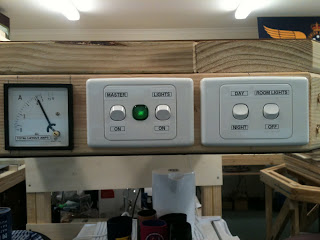It's been a while between blogs, however much has been happening on the layout.
The mains power to the layout and accessories, as well as the lighting controls, have been centralised on the end of the peninsula.
 |
| Centralised layout power and lighting controls |
The amp meter is an indication of the total current draw of the layout and accessories from the main 240V supply. The green neon lamp is an indication, when leaving, that nothing has been inadvertently left on (eg: soldering iron, hot glue gun, DCC booster etc) as it is easily seen from the exit doorway when you switch the room lights off.
All of the PSX circuit breakers (5) and auto-reverser (1) have been wired into place, and the bus wires all terminated and labelled on a terminal strip.
 |
| PSX Circuit Breakers & Autoreverser |
The booster has been temporarily wired in (I intend to hardwire the RRAmp meter when the layout track laying and dropper wiring is completed and tested).
 |
| The lead-in track and the start of the inner helix |
Track laying has begun, with the inner helix commencing construction, and is now 4 turns complete, only 4 more to go. Each loop of the helix is electrically gapped so that block detection can be used. I will be using a Digitrax BDL168 to monitor 16 blocks, and give an indication via remote LED panel as to the travel/location of a train through the helix. There will also be viewing windows around the outside to allow visual contact for train crews.
 |
| The helix after 1 1/2 turns, with H220 and 1BCE as a test train |
 |
| Halfway round the 4th turn |




